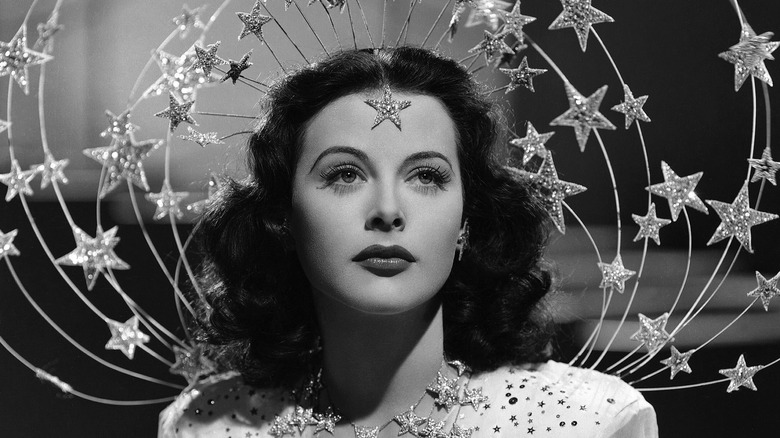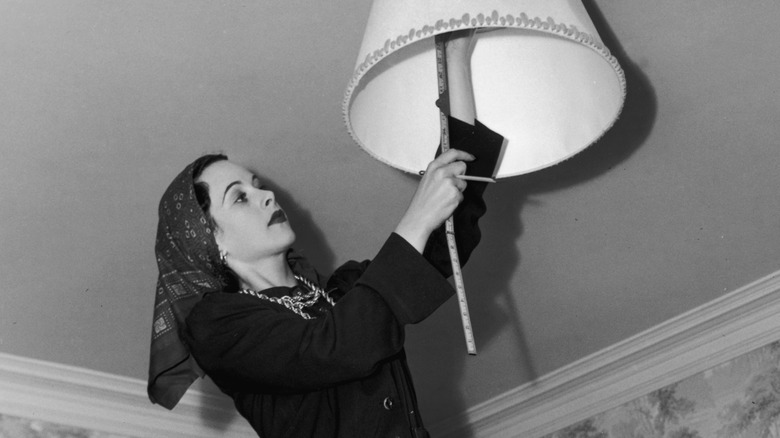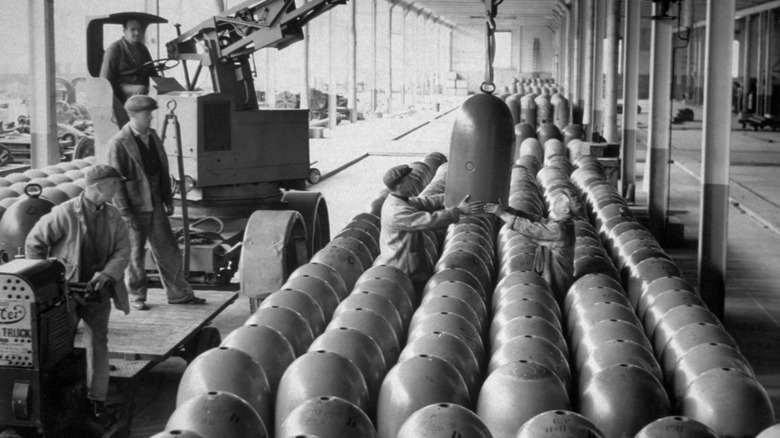The Stunning Hollywood Actress Who Was Also An Accomplished Inventor
Hollywood stardom has a way of dominating a person's reputation, in their lifetime and after. None of the leading men who served in World War II, for instance, are remembered for their service as much as they are for the roles they played. And posterity has primarily remembered Austrian-born starlet Hedy Lamarr as an exotic, mysterious femme fatale from the Golden Age of Hollywood.
As reported by TCM, studio publicity billed her as the "world's most beautiful woman," an image built up by appearances in "Algiers," "White Cargo," and an early, scandalous nude scene in the Austrian film "Ecstasy." She once complained that "any girl can be glamorous; all you have to do is stand still and look stupid," and typecasting left her little opportunity for different roles (per Britannica). She briefly tried to shape her career with her own production company in the 1940s, but she returned to the studio system before the decade was out and soon faded away from the spotlight.
In her autumn years, Lamarr made headlines for shoplifting, her scandalous autobiography, and a flurry of lawsuits she filed against ghostwriters, repairmen, and Mel Brooks. Blindness left her a recluse by the end of her life. But even upon her death in 2000, the strongest memories of Lamarr were of her beauty and stardom. Even the contemporary children's show "Hey Arnold!" traded on that reputation.
But Lamarr has gotten a delayed posthumous recognition for more than her onscreen persona. She was also a talented and largely self-taught inventor. And one of her inventions helped pave the way for the modern Wi-Fi you're probably using to read this article.
Lamarr was a self-taught inventor
Biographer Richard Rhodes told History that Hedy Lamarr showed signs of an inquisitive and inventive mind at an early age. Growing up in Austria, her father taught her how electricity worked, and she disassembled a music box at age 5 to puzzle out its workings (she put it back together by herself). But even as a youngster her ambition was to be a movie star. She cut school to get an early opportunity in show business, and even if she had wanted to pursue inventing professionally, that wasn't an option open to girls from well-off families in the Austria of her day.
Lamarr's formal education consisted of regular school, the typical pursuits of a society girl, and on-the-job training in movies. Eventually, she married Fritz Mandl, head of a munitions business, which gave her renewed exposure to the technical world. In her husband's company, Lamarr got an earful of details on the weapons he was preparing to sell to the fascists of 1930s Europe. The marriage was unhappy on account of Mendl's jealousy, though, and his coziness with the Nazis and their antisemitic politics (Lamarr was from a secular Jewish family) convinced her to flee Mandl and Austria for Hollywood.
Even after joining the ranks of Hollywood stars, Lamarr continued to dabble in engineering and inventing as her hobby of choice. She skipped Hollywood parties to tinker with household objects or sketch out ideas for inventions. And she traded ideas with aviator-turned-mogul Howard Hughes.
Her contribution to Wi-Fi was originally meant for war
Most of Hedy Lamarr's inventions were solutions to everyday problems around the house: A dog collar that glows in the dark, a bathroom seat that can swivel in and out of the shower. But her claim to being one of the mothers of modern Wi-Fi technology goes back to World War II. During the conflict, she met composer George Antheil at a Hollywood party, and the pair struck up a friendship. Antheil was similarly interested in inventing, and both of them wanted to contribute to the war effort. Lamarr, with her background in munitions thanks to her first marriage, likely hit on the idea of improving torpedo accuracy.
Biographer Richard Rhodes thinks that Lamarr and Antheil, through playing piano together, developed the idea of synchronizing communications between a fired torpedo and its control center via two clocks and a tape. Their proposed system would provide a continuous signal, and because the missile was traveling through various frequencies, anyone trying to jam the signal wouldn't be able to pinpoint its location. Lamarr dubbed the concept "frequency hopping," and she and Antheil took it to the National Inventors' Council.
Lamarr and Antheil were the brains behind frequency hopping, while a physicist from the California Institute of Technology worked out the details. They received a patent for their work, but the U.S. Navy, apparently considering ideas from entertainers inherently ridiculous, refused to consider frequency hopping. Lamarr wound up redirecting her wartime contributions to selling war bonds as a Hollywood star.
Frequency hopping took off in the 1970s, unknown to Lamarr
Though it was George Antheil who brought the frequency hopping proposal to the U.S. Navy's attention, it's been speculated that Hedy Lamarr's sex worked against the idea (men took credit for many inventions and discoveries by women, after all). The concept was eventually applied during the Cuban Missile Crisis, three years after his death. Its use was different than intended — rather than try to guide torpedoes, the Navy used it for communications. The military branch also modified Lamarr's original design to use transistors rather than clocks. Still, it was Lamarr and Antheil's plan.
The technology was expanded in the 1970s, when it was used for car phones, and again in the 1980s, when it was applied to radio and TV. Modern Wi-Fi and Bluetooth technology have come a long way from a patent built around two synchronized clocks, but they do rely on the basic idea behind frequency hopping as devised by Lamarr and Antheil.
Lamarr herself was unaware of how widespread her concept became until near the end of her life, well after the expiration of her patent. In her seclusion, and in the midst of personal problems, she turned her inventing talents to improving plastic surgery. After learning what her invention had birthed, she felt no need for compensation — but she did want recognition. When she was given the Electronic Frontier Foundation Pioneer Award in 1997, two years before her death, she said in her call-in acceptance speech (per History): "Well, it's about time."
Want some more weird and interesting history? Check out history's most respected geniuses that turned into madmen.



